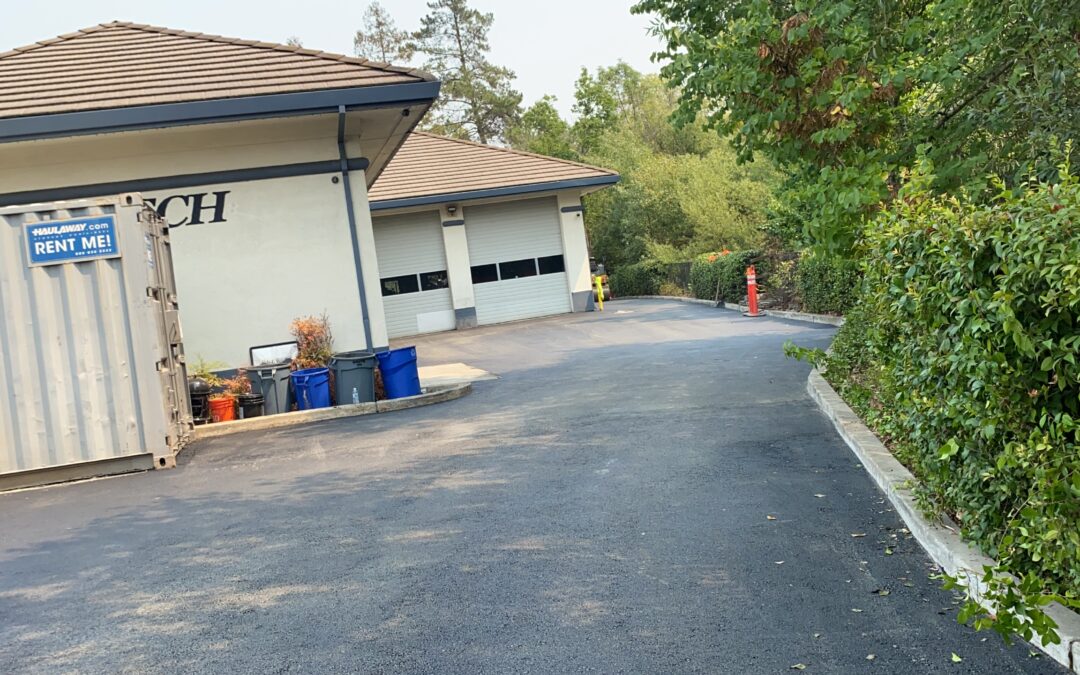Homeowners’ Associations (HOAs) are responsible for maintaining common areas within communities, ensuring that shared spaces remain safe, attractive, and functional. One of the most significant aspects of this responsibility is the maintenance and management of asphalt-paved areas, such as roads, driveways, and parking lots. Proper asphalt paving and maintenance can extend the lifespan of these surfaces, improve property values, and enhance the overall appearance of the community. This article addresses frequently asked questions (FAQs) about asphalt paving that HOAs often encounter, providing detailed insights and expert advice.
1. What is Asphalt, and Why is it Commonly Used in HOA Communities?
Overview: Asphalt is a composite material commonly used for constructing and maintaining roads, driveways, and parking lots. It is made up of aggregates (such as sand, gravel, and crushed stone) and a binder known as bitumen, which holds the aggregates together.
Advantages for HOAs:
- Durability: Asphalt is highly durable, with the ability to withstand varying weather conditions and heavy traffic.
- Cost-Effectiveness: Asphalt is less expensive than concrete and other paving materials, making it a budget-friendly choice for large-scale HOA projects.
- Quick Installation: Asphalt can be laid and cured quickly, minimizing disruptions to the community.
- Smooth Surface: Asphalt provides a smooth driving surface, enhancing safety and comfort for residents.
Common Uses in HOAs:
- Roadways: Most community roads within HOAs are paved with asphalt due to its cost-efficiency and durability.
- Driveways: Individual driveways are often paved with asphalt, providing a consistent appearance across the community.
- Parking Lots: Asphalt is the material of choice for parking areas, offering easy maintenance and repair options.
2. How Long Does Asphalt Last, and What Factors Affect Its Lifespan?
Typical Lifespan: Asphalt surfaces can last anywhere from 15 to 25 years, depending on various factors, including the quality of installation, environmental conditions, and maintenance practices.
Factors Influencing Longevity:
- Quality of Installation: Proper installation is critical to the longevity of asphalt. Poorly installed asphalt may develop cracks, potholes, and other issues more quickly.
- Climate: Extreme temperatures, whether hot or cold, can accelerate the aging process of asphalt. For instance, freeze-thaw cycles in colder climates can cause the asphalt to crack, while intense heat can lead to softening and deformation.
- Traffic Load: Areas with heavy vehicle traffic will wear down faster than those with lighter use. Parking lots and main roads within a community are particularly susceptible to wear and tear.
- Maintenance: Regular maintenance, such as sealcoating and crack filling, can significantly extend the life of an asphalt surface by protecting it from the elements and preventing minor issues from becoming major problems.
3. What Maintenance Practices Should HOAs Implement for Asphalt Pavement?
Sealcoating: Sealcoating involves applying a protective layer to the surface of the asphalt. This process helps to shield the asphalt from UV rays, water, oil spills, and other damaging elements. It is typically recommended every 2-3 years.
- Benefits: Extends the lifespan of the pavement, enhances appearance, and provides a uniform black finish.
- Cost: The cost of sealcoating generally ranges from $0.15 to $0.30 per square foot, depending on the size of the area and the type of sealant used.
Crack Filling: Cracks are inevitable over time, but addressing them promptly can prevent water infiltration and subsequent damage.
- Timing: Crack filling should be done annually or as soon as cracks are noticed.
- Cost: Crack filling usually costs between $0.50 and $1.00 per linear foot.
Pothole Repairs: Potholes are more severe forms of asphalt damage that occur when water infiltrates and weakens the sub-base, causing the surface to collapse. Timely repairs are essential to prevent further deterioration.
- Method: Potholes can be repaired using either a temporary cold patch or a more permanent hot mix asphalt.
- Cost: Repair costs vary widely, ranging from $50 to $150 per pothole, depending on its size and depth.
Resurfacing: Asphalt resurfacing involves adding a new layer of asphalt over the existing surface, which can restore the pavement’s appearance and structural integrity without the need for complete replacement.
- Timing: Resurfacing is typically done every 15-20 years or when the surface shows significant signs of wear.
- Cost: Resurfacing costs range from $1.50 to $3.00 per square foot.
4. How Should an HOA Choose an Asphalt Contractor?
Key Considerations:
- Experience and Reputation: Look for contractors with extensive experience in asphalt paving and a solid reputation within the community. Checking references and reading online reviews can provide valuable insights.
- Licensing and Insurance: Ensure the contractor is properly licensed and insured. This protects the HOA from liability in case of accidents or damage during the project.
- Detailed Proposals: A reputable contractor should provide a detailed proposal outlining the scope of work, materials to be used, timeline, and costs. Avoid contractors who offer vague estimates.
- Warranty: A good contractor should offer a warranty on their work. This provides peace of mind and ensures the HOA is covered in case any issues arise post-installation.
Questions to Ask Potential Contractors:
- How many similar projects have you completed in the past year?
- What is your process for ensuring quality control during the installation?
- Can you provide references from other HOAs or similar organizations?
- What is your timeline for project completion, and how do you handle unexpected delays?
- What kind of warranty do you offer on your work?
5. What Are the Common Signs That Asphalt Needs to Be Repaired or Replaced?
Visible Cracks: Cracks are the most common sign of asphalt deterioration. While small cracks can be filled, extensive cracking may indicate that the asphalt needs more significant repairs or even resurfacing.
Potholes: Potholes are a clear sign that the asphalt has weakened and needs immediate attention. They can pose a safety hazard and lead to further damage if not repaired promptly.
Faded Color: As asphalt ages, it loses its rich black color and becomes gray. This is not just an aesthetic issue; it also indicates that the binder is deteriorating and the asphalt is becoming more susceptible to damage.
Pooling Water: Water pooling on the surface after rain suggests that the asphalt is no longer level or that drainage issues exist. Standing water can quickly lead to cracks and potholes if not addressed.
Rutting and Deformation: Rutting (indentations in the pavement caused by traffic) and other deformations indicate that the asphalt is no longer strong enough to support the load. This is often a sign that the pavement needs to be resurfaced or replaced.
6. How Does Asphalt Paving Impact Property Values in an HOA Community?
Curb Appeal: Well-maintained asphalt surfaces significantly enhance the curb appeal of a community. Smooth, dark, and clean roads and driveways create a positive first impression for visitors and potential homebuyers.
Safety: Properly maintained asphalt reduces the risk of accidents, such as slips and falls, which can occur on cracked or uneven surfaces. This contributes to the overall safety and livability of the community, which is a key factor in property values.
Long-Term Investment: Investing in quality asphalt paving and regular maintenance can prevent more costly repairs down the line. A community with well-maintained infrastructure is more likely to attract buyers, maintain property values, and minimize long-term expenses for residents.
Consistency: Uniformity in the appearance and quality of asphalt across the community reflects well on the HOA’s management and stewardship. Consistent paving can enhance the overall aesthetic cohesion of the neighborhood, making it more attractive to prospective buyers.
7. What Environmental Considerations Should HOAs Be Aware of When Paving with Asphalt?
Recycling and Sustainability: Asphalt is one of the most recycled materials in the world. When old asphalt is removed, it can be reclaimed and reused in new projects, reducing the environmental impact and conserving natural resources.
- Reclaimed Asphalt Pavement (RAP): Using RAP in new asphalt mixes can reduce the need for virgin materials and lower the overall cost of paving.
- Warm Mix Asphalt: This newer technology allows asphalt to be mixed and laid at lower temperatures, reducing energy consumption and emissions.
Drainage and Water Runoff: Proper drainage is crucial in asphalt paving projects. Poor drainage can lead to water pooling, which damages the pavement and can cause environmental issues, such as erosion and pollution of nearby water sources.
- Permeable Asphalt: In areas where stormwater management is a concern, HOAs might consider using permeable asphalt, which allows water to pass through the surface and reduce runoff.
Chemical Exposure: The production and installation of asphalt involve the use of petroleum-based products, which can release volatile organic compounds (VOCs) into the environment. HOAs should work with contractors who follow best practices for minimizing emissions and exposure during paving projects.
Conclusion
Asphalt paving is a significant investment for any HOA, requiring careful consideration and planning. By understanding the basics of asphalt, implementing regular maintenance practices, selecting reputable contractors, and staying informed about the latest developments in asphalt technology, HOAs can ensure that their paved surfaces remain in excellent condition for years to come. This not only enhances the safety and appearance of the community but also helps protect and even increase property values. For HOAs, asphalt paving is not just about the initial cost—it’s about long-term value, sustainability, and community satisfaction.

